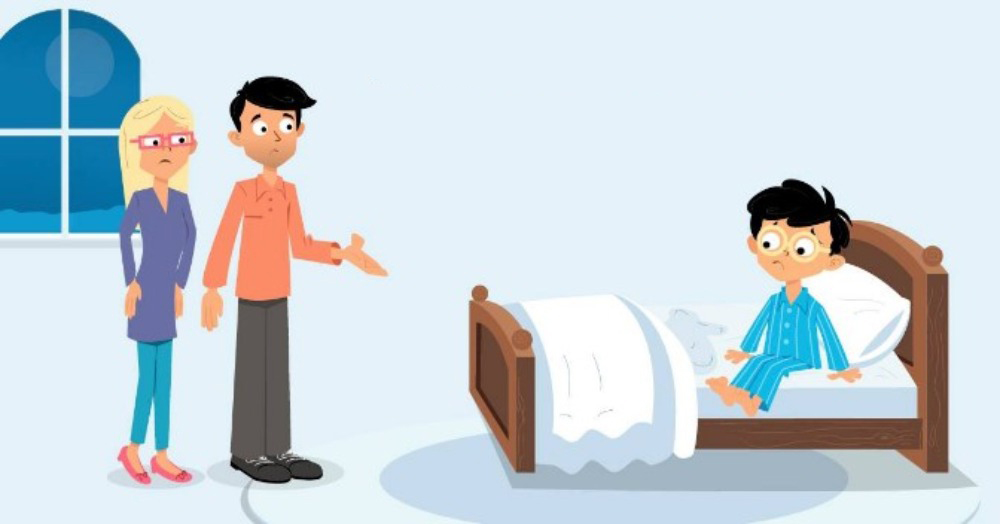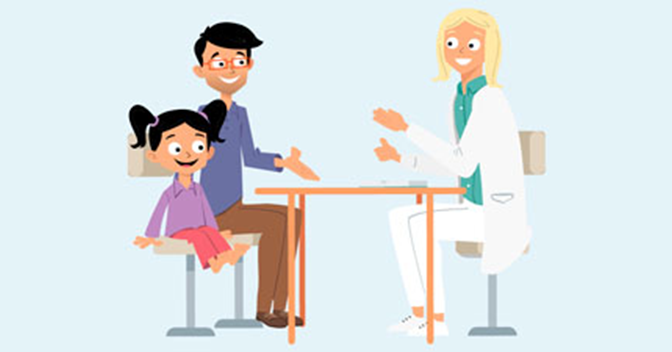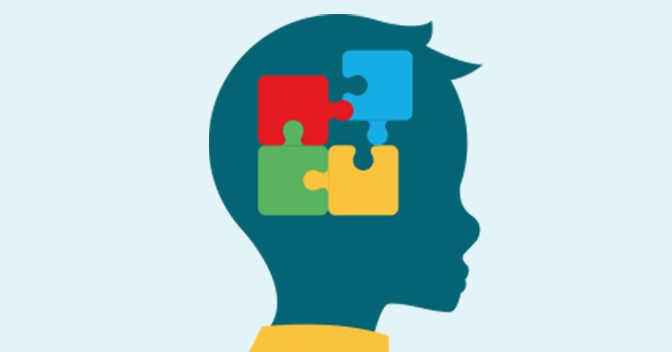
Bedwetting, or nocturnal enuresis, is a common condition affecting around 15–20% of 5 year-olds, and 5% of 10 year-olds.1 Severity can vary, and approximately 10% of children with bedwetting experience more than 3 wet nights every week.2
Impact of bedwetting on the child

Patient quotations:
Bedwetting can impact upon children’s sleep quality, for example when the child wakes fully due to the discomfort of wet bedding and the need to change bedclothes.11 Children with enuresis may also have altered sleep patterns, including differing sleep architecture and efficiency, although further research is needed to reach consensus on the exact nature, and role, of sleep disturbances in enuresis.12–17 Whatever the relationship between enuresis and sleep, studies show that enuresis is associated with tiredness during the day6,11 and problems at school.6

Impact of bedwetting on families

For families of children with nocturnal enuresis, there are multiple aspects of the condition that can be stressful or demanding, including interrupted sleep, increased washing, disruption in the mornings before school, and worry about their child’s wellbeing or ability to spend nights away from home.8 Bedwetting is associated with mothers’ negative mood18 and parental anger,19 and with increased risk of physical or other punishment of the child.8,19,20
Like their children, parents may also have feelings of embarrassment and shame about the condition,21,22 which can impact upon their willingness to talk to others or seek help. Wider family members may also be perceived as judgmental or disapproving.8 Parental knowledge about the aetiology of the condition and effective treatments is often lacking,23,24 which may reduce the likelihood of them discussing the problem with a healthcare professional.25 Some parents report that support from professionals is not always adequate – clinicians did not ask the family if they needed help, were perceived as awkward talking about the problem, or they did not seem to take it seriously.21 It is important, therefore, for physicians to be open and proactive in initiating dialogue regarding bedwetting at routine appointments.24
Healthcare professionals should also be prepared to tackle some of the misconceptions regarding the best way to treat the condition. Recent research shows that the majority of websites, found in internet searches relating to bedwetting, provide information that is not consistent with current recommendations from the International Children’s Continence Society (ICCS), and many sites are layperson generated.26
In some cases, treatment for bedwetting may also lead to increased stress for families. The alarm is likely to cause sleep disruption for parents and the rest of the family (but not necessarily patients),8 and this often leads to premature discontinuation of treatment.27,28 Selecting treatment that is right for the whole family maximises chances of adherence and success. This should be a key consideration.
Parent quotations:
References
- Kiddoo D. Nocturnal enuresis. BMJ Clin Evid. 2011;2011:0305.
- Chang P, Chen WJ, Tsai WY, Chiu YN. An epidemiological study of nocturnal enuresis in Taiwanese children. BJU Int. 2001;87(7):678-681. doi:10.1046/j.1464-410x.2001.02161.x
- Vande Walle J, Rittig S, Bauer S, Eggert P, Marschall-Kehrel D, Tekgul S. Practical consensus guidelines for the management of enuresis. Eur J Pediatr. 2012;171(6):971-983. doi:10.1007/s00431-012-1687-7
- Iscan B, Ozkayın N. Evaluation of health-related quality of life and affecting factors in child with enuresis. J Pediatr Urol. 2020;16(2):195.e1-195.e7. doi:10.1016/j.jpurol.2019.12.018
- Whale K, Cramer H, Joinson C. Left behind and left out: The impact of the school environment on young people with continence problems. Br J Health Psychol. 2018;23(2):253-277. doi:10.1111/bjhp.12284
- Maternik M. Understanding of and misconceptions around monosymptomatic nocturnal enuresis: findings from patient and physician surveys. J Pediatr Urol. 2019;15(1):37.e1-37.e8. doi:10.1016/j.jpurol.2018.09.013
- Hu HJ, Zhang ZW, Liang Y, et al. Prevalence, Risk Factors, and Psychological Effects of Primary Nocturnal Enuresis in Chinese Young Adults. Int Neurourol J. 2021;25(1):84-92. doi:10.5213/inj.2040398.149
- Morison MJ. Living with a young person who wets the bed: the families’ experience. Br J Nurs. 2000;9(9):572-574, 576, 578 passim. doi:10.12968/bjon.2000.9.9.6294
- Morison MJ. Family Perspectives on Bed Wetting in Young People. phd. The Open University; 1995. Accessed April 13, 2022. http://oro.open.ac.uk/63363/
- Saarikoski A, Koppeli R, Salanterä S, Taskinen S, Axelin A. Voiding school as a treatment of daytime incontinence or enuresis: Children’s experiences of the intervention. Journal of Pediatric Urology. 2018;14(1):56.e1-56.e7. doi:10.1016/j.jpurol.2017.09.009
- Cohen-Zrubavel V, Kushnir B, Kushnir J, Sadeh A. Sleep and Sleepiness in Children with Nocturnal Enuresis. Sleep. 2011;34(2):191-194.
- Van Herzeele C, Dhondt K, Roels SP, et al. Periodic limb movements during sleep are associated with a lower quality of life in children with monosymptomatic nocturnal enuresis. Eur J Pediatr. 2015;174(7):897-902. doi:10.1007/s00431-014-2474-4
- Nevéus T. Pathogenesis of enuresis: Towards a new understanding. Int J Urol. 2017;24(3):174-182. doi:10.1111/iju.13310
- Ma J, Li S, Jiang F, et al. Relationship between sleep patterns, sleep problems, and childhood enuresis. Sleep Med. 2018;50:14-20. doi:10.1016/j.sleep.2018.05.022
- Collier E, Varon C, Van Huffel S, Bogaert G. Enuretic children have a higher variability in REM sleep when comparing their sleep parameters with nonenuretic control children using a wearable sleep tracker at home. Neurourology and Urodynamics. 2020;39(1):367-375. doi:10.1002/nau.24215
- Pedersen MJ, Rittig S, Jennum PJ, Kamperis K. The role of sleep in the pathophysiology of nocturnal enuresis. Sleep Med Rev. 2020;49:101228. doi:10.1016/j.smrv.2019.101228
- Martenstyn JA, Machaalani R, Caldwell P, Waters KA. Relationship between sleep respiration, architecture and childhood enuresis: Correlates between polysomnography and questionnaire. Journal of Paediatrics and Child Health. 2021;57(12):1923-1928. doi:10.1111/jpc.15613
- Yaradilmiş RM, Büyükkaragöz B, Yilmaz AÇ, Tayfur AÇ. Severity of self-reported depressive symptomatology and relevant factors in children with primary monosymptomatic nocturnal enuresis and their mothers. Pediatr Nephrol. 2020;35(7):1277-1285. doi:10.1007/s00467-020-04512-8
- Tai TT, Tai BT, Chang YJ, Huang KH. Parental perception and factors associated with treatment strategies for primary nocturnal enuresis. J Pediatr Urol. 2017;13(3):272.e1-272.e8. doi:10.1016/j.jpurol.2016.12.025
- Sá CA, Gusmão Paiva AC, de Menezes MCLB, et al. Increased Risk of Physical Punishment among Enuretic Children with Family History of Enuresis. The Journal of Urology. 2016;195(4, Part 2):1227-1231. doi:10.1016/j.juro.2015.11.022
- Cederblad M, Nevéus T, Åhman A, Österlund Efraimsson E, Sarkadi A. “Nobody asked us if we needed help”: Swedish parents experiences of enuresis. J Pediatr Urol. 2014;10(1):74-79. doi:10.1016/j.jpurol.2013.06.006
- Alanazi ANH, Alanazi RSM, Alanazi EN, Alanazi RM, Rabbani U. Prevalence of Nocturnal Enuresis Among Children and Its Association With the Mental Health of Mothers in Northern Saudi Arabia. Cureus. 2022;14(2):e22232. doi:10.7759/cureus.22232
- Schlomer B, Rodriguez E, Weiss D, Copp H. Parental beliefs about nocturnal enuresis causes, treatments, and the need to seek professional medical care. J Pediatr Urol. 2013;9(6 Pt B):1043-1048. doi:10.1016/j.jpurol.2013.02.013
- Grzeda MT, Heron J, Tilling K, Wright A, Joinson C. Examining the effectiveness of parental strategies to overcome bedwetting: an observational cohort study. BMJ Open. 2017;7(7):e016749. doi:10.1136/bmjopen-2017-016749
- Dunlop A. Meeting the Needs of Parents and Pediatric Patients: Results of a Survey on Primary Nocturnal Enuresis. Clin Pediatr (Phila). 2005;44(4):297-303. doi:10.1177/000992280504400403
- Whitley JA, Kieran K. Accuracy and comprehensiveness of publicly-available online data about bedwetting: An actionable opportunity to improve parent and caregiver self-education. Journal of Pediatric Urology. 2020;16(5):661.e1-661.e8. doi:10.1016/j.jpurol.2020.07.013
- Evans J, Malmsten B, Maddocks A, Popli HS, Lottmann H. Randomized comparison of long-term desmopressin and alarm treatment for bedwetting. Journal of Pediatric Urology. 2011;7(1):21-29. doi:10.1016/j.jpurol.2010.04.018
- Tai TT, Tai BT, Chang YJ, Huang KH. The Importance of Understanding Parental Perception When Treating Primary Nocturnal Enuresis: A Topic Review and an Institutional Experience. Res Rep Urol. 2021;13:679-690. doi:10.2147/RRU.S323926


